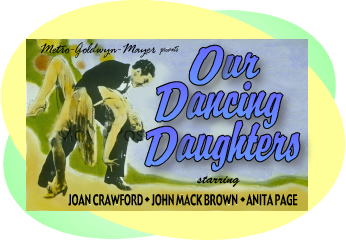

As a social commentary, "Our Dancing Daughters" isn't bad. It's also good drama, but in both cases, one has to remember that this is Hollywood's depiction of the wild and reckless youth of the late 1920's.
With the families of the three female leads, author Josephine
Lovett seems to have provided situations with 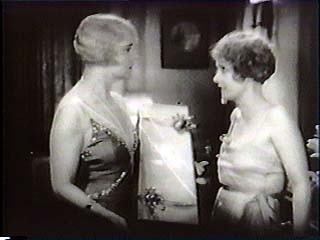 which
most girls of the period could identify. Ann lives with her mother
whose only dream is that her daughter use her beauty to land a
rich husband and support her mother in fine fashion. Bea's parents
are very strict warning her and her brother, Freddie, of the consequences
if they smoke at the party and giving them a midnight curfew.
Diana, on the other hand, has extremely lenient parents. She lets
them know she will be out all night at the party, and that's OK
with them.
which
most girls of the period could identify. Ann lives with her mother
whose only dream is that her daughter use her beauty to land a
rich husband and support her mother in fine fashion. Bea's parents
are very strict warning her and her brother, Freddie, of the consequences
if they smoke at the party and giving them a midnight curfew.
Diana, on the other hand, has extremely lenient parents. She lets
them know she will be out all night at the party, and that's OK
with them.
The story lays this groundwork in the very beginning because the personalities of these three main characters and their backgrounds are critical to the development of the story. For example, Ann does marry rich, but her marriage is a failure because there's no love there. This does not surprise us considering the fact that her mother taught her that money is a reason to marry.
In spite of having strict parents, Bea has a secret in her past that we can only assume is some sort of sexual indiscretion. Maybe the story is trying to tell us this is a natural result of parents being too strict??? At any rate, this comes back to haunt Bea's marriage causing problems between her and her husband.
As mentioned, Diana has the most lenient parents. It must
be noted, too, that, in spite of this leniency from her parents
(or because of it, who knows?) Diana has the best parent-child
relationship of the three, appears to be the most well-adjusted,
and is the only one who has no hint of "scandalous"
behavior in her life. In the end, 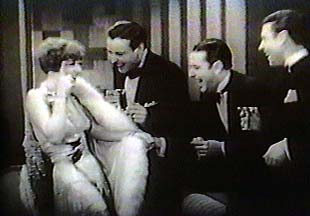 when
she finally does decide to marry, we are led to believe her marriage
will be the only solid one of the three.
when
she finally does decide to marry, we are led to believe her marriage
will be the only solid one of the three.
Whether the viewer agrees with these presentments or not will probably correlate to the individual's own upbringing and experience. However, one thing's for sure, movies, and MGM in particular, had the knack for making the public believe this was reality.
MGM also realized that movie-goers enjoyed seeing wealth and opulence, and the characters in this story are all members of the wealthiest class, having no visible means of support and seemingly spending all their time seeking ways to entertain themselves. We are told Ben played football for Alabama and has inhertied millions, so we can assume he is a college graduate and doesn't need to work. However, none of the others has any visible means of support, don't seem to attend school anywhere, and could be any age from 18 to 28 - not that it matters to the story.
As noted, it is a good drama, though. We are drawn into
the characters because they do have identifiable characteristics
and are well-developed. Diana, for example, appears to be fun-loving,
even somewhat "wild," always the life of the party and
the most popular girl with the boys. Yet, she is also the most
virtuous of the lot. Distraught over having lost Ben to Ann's
deceitful ways, she runs to her parents crying, "I not a
liar - a 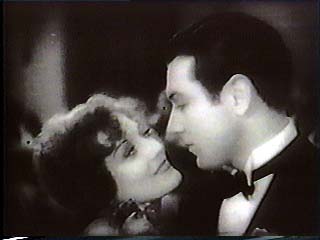 cheat. I've been decent. And I've
lost - and the others have won! Why - why?"
cheat. I've been decent. And I've
lost - and the others have won! Why - why?"
But it is also this somewhat paradoxical character of hers that creates the central conflict in the story. Ben sees Diana's "wild" side and assumes she is not good marriage material. So, he marries Ann. Actually Ann is just the opposite of Diana. Ann puts on a reserved and virtuous front but is actually deceitful and unscrupulous. Diana, on the other hand, puts on the "wild" front, but is really an honest and virtuous girl.
It is hard to imagine anyone else in these roles. Joan Crawford is superb as Diana, and Anita Page is excellent as Ann and deserved a much longer and more successful career than she had. No wonder MGM brought these ladies back together again in "Our Modern Maidens" and "Our Blushing Brides." Dorothy Sebastian, Johnny Mack Brown and Nils Asther are also well cast.
What Others Said About "Our Dancing Daughters"
Joe Franklin (Classics of the Silent Screen, 1959,
Citadel Press, Inc.)
"The most famous of all the jazz-age films is perhaps Clara
Bow's "It." . . . Far better were such notable lesser
films as "Walking Back," which had some jim-dandy sequences
in it. But I think MGM's "Our Dancing 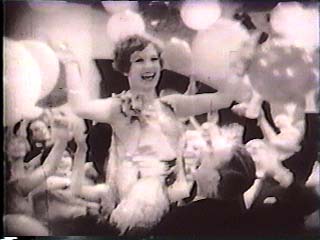 Daughters,"
directed by Harry Beaumont in 1928, was perhaps the best of the
lot. Certainly it was the l lushest of the lot . . ."
Daughters,"
directed by Harry Beaumont in 1928, was perhaps the best of the
lot. Certainly it was the l lushest of the lot . . ."
James Card (Seductive Cinema, Alfred A. Knopf, 1994)
"For the social historian, "Our Dancing Daughters"
is an important film. It is a morality play of the latter twenties
- a visually eloquent dramatization, for popular understanding,
of the era's basic clash between a puritanical heritage and the
postwar, youthful urge toward a new attitude to sexual freedom
and the hedonistic enjoyment of all possible privileges of a prosperous
segment of society."
William K. Everson (American Silent Film, DaCapo
Press, 1998)
"Our Dancing Daughters," while ofen cited s the 'definitive"
jazz-age film, is really no more than the definitive record of
what MGM - a glossy studio run by rich executive siwth very little
contact with everyday life - thought the jazz age was all
about."
New York Times review, October 8, 1928
"There is nothing startlingly novel about 'Our Dancing Daughters,'
for while there is an undeniable vivacity to many of the scenes,
the action is not particularly well portrayed and it is frequently
anything but conservative. . . The wide-eyed Joan Crawford, who
is attractive in many of the scenes, figures as one of the dancing
daughters. . . John Mack Brown is sympathetic as Mr. Blain. Dorothy
Sebastian is appealing as Beatrice. Anita Page gives a fairly
good portrayal of her idea of a dancing daughter."
Return to "Our Dancing Daughters" page
copyright 1999 by Tim Lussier, all rights reserved